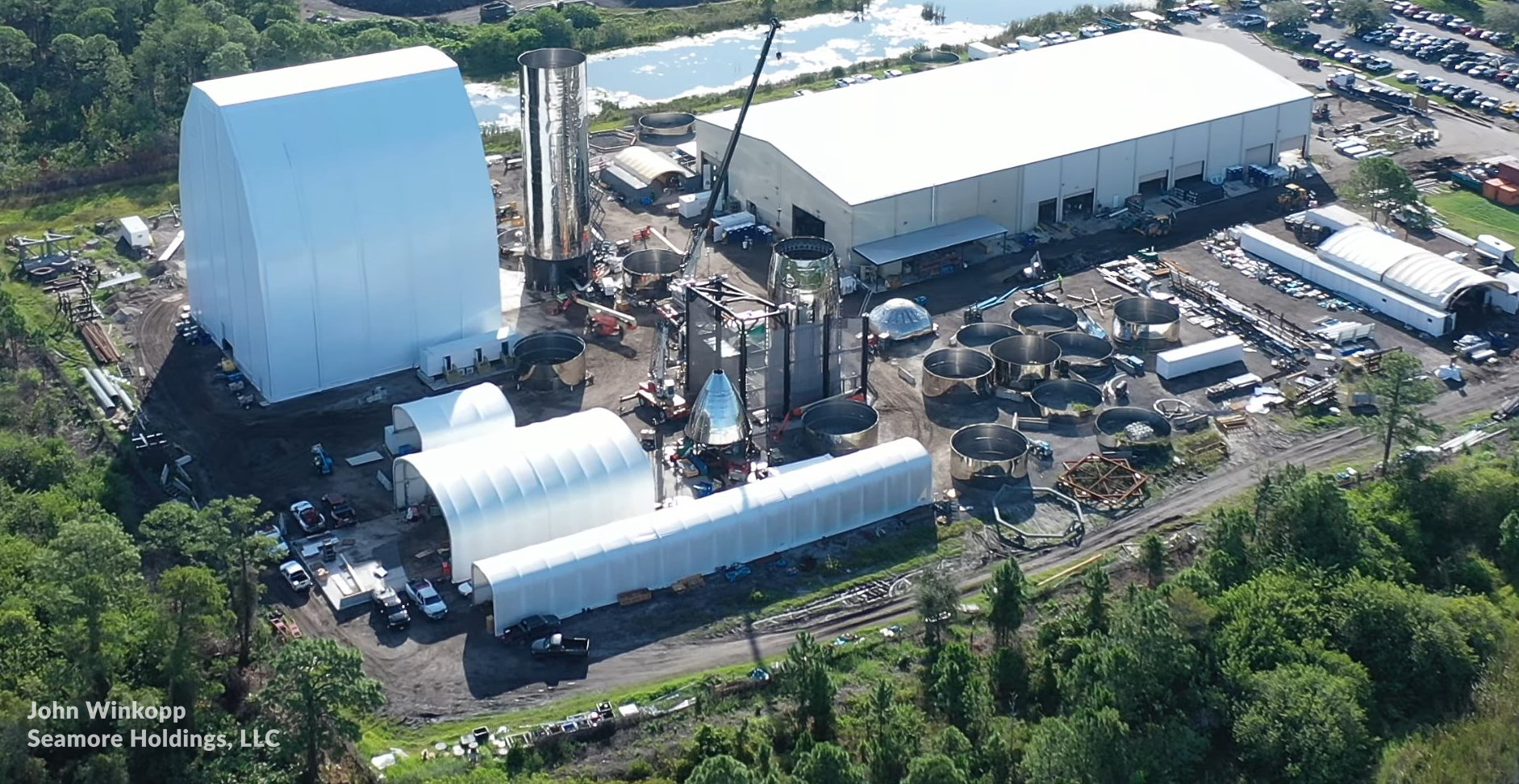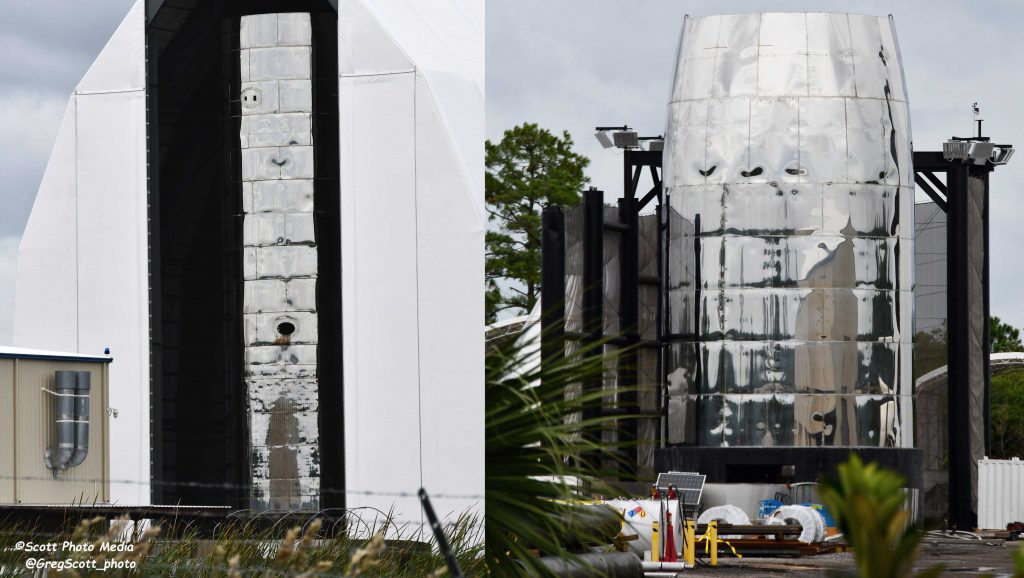

News
SpaceX scraps Florida Starship Mk2 prototype
SpaceX has scrapped the lone Starship prototype built in Florida in 2019, surprising very few.
Beginning a few months after work began on Starship Mk1 at SpaceX’s South Texas production facilities, a separate team in Cocoa, Florida was tasked with building a similar Starship Mk2 prototype. Not much is known about Mk2 relative to its much more publicized sibling but unofficial photos and videos taken over the course of 2019 suggested that SpaceX had effectively completed most of Starship Mk2 by the end of last year. However, built dozens of miles and several waterways away from a practical test facility, actually testing a Starship prototype assembled at SpaceX’s Cocoa facilities was always going to be an uphill battle.
To warrant the cost and effort that would be required to transport something as large as a vertical Starship from Cocoa, Florida to Cape Canaveral, Mk2 would have to be able offer something invaluable during testing. Now eight months after Starship Mk1 was destroyed during one of its first real tests, that was sadly not the case and SpaceX has chosen the simplest route forward – scrapping Mk2 where it sits.

In November 2019, SpaceX installed Starship Mk1 on a test stand in Boca Chica, Texas and began a series of tests. The ship passed an initial ambient temperature pressure test on the 18th but failed spectacularly during its first cryogenic proof test, said by SpaceX to have “pressurize[d] systems to the max.” Excluding Starhopper, Starship Mk1 was about as rough of a prototype as SpaceX could have feasibly built and the fact that it survived any length of time under cryogenic loads and pressures was fairly impressive.
Welded together almost entirely out in elements on the South Texas Gulf coast, the total success of Starship Mk1 (and its similar Mk2 sibling) would have flown in the face of almost every single tenet of modern aerospace production. As noted in a Teslarati article describing the Starship’s demise, the Mk1 production apparatus left plenty of room for improvement.
“[Videos of the failure implicated] the weld connecting the LOX dome to the cylindrical body of Starship’s LOX tank, pointing to a bad weld joint as the likeliest source of the failure. Although that hardware failure is unfortunate, Mk1’s loss will hopefully guide improvements in Starship’s design and manufacturing procedures.”
Teslarati.com — November 20th, 2019
That is precisely what SpaceX did – and was likely already doing – in response to Mk1’s failure. Just two months later, SpaceX successfully tested a steel Starship tank built in upgraded facilities with upgraded methods and reached pressures of 7.1 bar (~103 psi) before failing – likely a 50% improvement or better relative to Mk1. A second tank completed weeks later in late January 2020 reached 7.5 bar, sprung a leak, was repaired, and ultimately soared to 8.5 bar (~125 psi) before failing. Per CEO Elon Musk, that would technically be enough for a Starship to launch humans into orbit with an industry-standard ~40% safety factor.
Finally, SpaceX recently proved that a full-scale, two-tank Starship prototype built with the same methods and facilities as those test tanks could achieve the same results, completing a ~7.5 bar (~110 psi) cryogenic proof test with Starship SN4 on May 10th.
Long story short, the methods SpaceX used to build Starship Mk1 and Mk2 were already proven redundant more than six months ago and buried even deeper in May 2020. Aside from serving as a museum piece, Starship Mk2’s fate was sealed – the only real question was how and when it would be scrapped. For now, SpaceX’s Starship program will be almost exclusively stationed in South Texas, where it appears to be in good hands. Starship SN5 is currently expected to attempt its first wet dress rehearsal (WDR) and static fire tests no earlier than July 17th (today) at 8 am CDT (13:00 UTC).
Check out Teslarati’s Marketplace! We offer Tesla accessories, including for the Tesla Cybertruck and Tesla Model 3.
News
Tesla begins Robotaxi certification push in Arizona: report
Tesla seems serious about expanding its Robotaxi service to several states in the coming months.

Tesla has initiated discussions with Arizona transportation regulators to certify its driverless Robotaxi service in the state, as per a recent report from Bloomberg News. The move follows Tesla’s launch of its Robotaxi pilot program in Austin, Texas, as well as CEO Elon Musk’s recent comments about the service’s expansion in the Bay Area.
The Arizona Department of Transportation confirmed to Bloomberg that Tesla has reached out to begin the certification process for autonomous ride-sharing operations in the state. While details remain limited, the outreach suggests that Tesla is serious about expanding its driverless Robotaxi service to several territories in the coming months.
The Arizona development comes as Tesla prepares to expand its service area in Austin this weekend, as per CEO Elon Musk in a post on X. Musk also stated that Tesla is targeting the San Francisco Bay Area as its next major market, with a potential launch “in a month or two,” pending regulatory approvals.
Tesla first launched its autonomous ride-hailing program on June 22 in Austin with a small fleet of Model Y vehicles, accompanied by a Tesla employee in the passenger seat to monitor safety. While still classified as a test, Musk has said the program will expand to about 1,000 vehicles in the coming months. Tesla will later upgrade its Robotaxi fleet with the Cyercab, a two-seater that is designed without a steering wheel.
Sightings of Cybercab castings around the Giga Texas complex suggests that Tesla may be ramping the initial trial production of the self-driving two-seater. Tesla, for its part, has noted in the past that volume production of the Cybercab is expected to start sometime next year.
In California, Tesla has already applied for a transportation charter-party carrier permit from the state’s Public Utilities Commission. The company is reportedly taking a phased approach to operating in California, with the Robotaxi service starting with pre-arranged rides for employees in vehicles with safety drivers.
News
Tesla sets November 6 date for 2025 Annual Shareholder Meeting
The automaker announced the date on Thursday in a Form 8-K.

Tesla has scheduled its 2025 annual shareholder meeting for November 6, addressing investor concerns that the company was nearing a legal deadline to hold the event.
The automaker announced the date on Thursday in a Form 8-K submitted to the United States Securities and Exchange Commission (SEC). The company also listed a new proposal submission deadline of July 31 for items to be included in the proxy statement.
Tesla’s announcement followed calls from a group of 27 shareholders, including the leaders of large public pension funds, which urged Tesla’s board to formally set the meeting date, as noted in a report from The Wall Street Journal.
The group noted that under Texas law, where Tesla is now incorporated, companies must hold annual meetings within 13 months of the last one if requested by shareholders. Tesla’s previous annual shareholder meeting was held on June 13, 2024, which placed the July 13 deadline in focus.
Tesla originally stated in its 2024 annual report that it would file its proxy statement by the end of April. However, an amended filing on April 30 indicated that the Board of Directors had not yet finalized a meeting date, at least at the time.
The April filing also confirmed that Tesla’s board had formed a special committee to evaluate certain matters related to CEO Elon Musk’s compensation plan. Musk’s CEO performance award remains at the center of a lengthy legal dispute in Delaware, Tesla’s former state of incorporation.
Due to the aftermath of Musk’s legal dispute about his compensation plan in Delaware, he has not been paid for his work at Tesla for several years. Musk, for his part, has noted that he is more concerned about his voting stake in Tesla than his actual salary.
At last year’s annual meeting, TSLA shareholders voted to reapprove Elon Musk’s compensation plan and ratified Tesla’s decision to relocate its legal domicile from Delaware to Texas.
Elon Musk
Grok coming to Tesla vehicles next week “at the latest:” Elon Musk
Grok’s rollout to Tesla vehicles is expected to begin next week at the latest.

Elon Musk announced on Thursday that Grok, the large language model developed by his startup xAI, will soon be available in Tesla vehicles. Grok’s rollout to Tesla vehicles is expected to begin next week at the latest, further deepening the ties between the two Elon Musk-led companies.
Tesla–xAI synergy
Musk confirmed the news on X shortly after livestreaming the release of Grok 4, xAI’s latest large language model. “Grok is coming to Tesla vehicles very soon. Next week at the latest,” Musk wrote in a post on social media platform X.
During the livestream, Musk and several members of the xAI team highlighted several upgrades to Grok 4’s voice capabilities and performance metrics, positioning the LLM as competitive with top-tier models from OpenAI and Google.
The in-vehicle integration of Grok marks a new chapter in Tesla’s AI development. While Tesla has long relied on in-house systems for autonomous driving and energy optimization, Grok’s integration would introduce conversational AI directly into its vehicles’ user experience. This integration could potentially improve customer interaction inside Tesla vehicles.
xAI and Tesla’s collaborative footprint
Grok’s upcoming rollout to Tesla vehicles adds to a growing business relationship between Tesla and xAI. Earlier this year, Tesla disclosed that it generated $198.3 million in revenue from commercial, consulting, and support agreements with xAI, as noted in a report from Bloomberg News. A large portion of that amount, however, came from the sale of Megapack energy storage systems to the artificial intelligence startup.
In July 2023, Musk polled X users about whether Tesla should invest $5 billion in xAI. While no formal investment has been made so far, 68% of poll participants voted yes, and Musk has since stated that the idea would be discussed with Tesla’s board.
-

 Elon Musk1 week ago
Elon Musk1 week agoTesla investors will be shocked by Jim Cramer’s latest assessment
-

 Elon Musk3 days ago
Elon Musk3 days agoElon Musk confirms Grok 4 launch on July 9 with livestream event
-

 Elon Musk18 hours ago
Elon Musk18 hours agoxAI launches Grok 4 with new $300/month SuperGrok Heavy subscription
-

 News7 days ago
News7 days agoTesla Model 3 ranks as the safest new car in Europe for 2025, per Euro NCAP tests
-

 Elon Musk2 weeks ago
Elon Musk2 weeks agoA Tesla just delivered itself to a customer autonomously, Elon Musk confirms
-

 Elon Musk1 week ago
Elon Musk1 week agoxAI’s Memphis data center receives air permit despite community criticism
-

 Elon Musk2 weeks ago
Elon Musk2 weeks agoTesla’s Omead Afshar, known as Elon Musk’s right-hand man, leaves company: reports
-

 News2 weeks ago
News2 weeks agoXiaomi CEO congratulates Tesla on first FSD delivery: “We have to continue learning!”

















